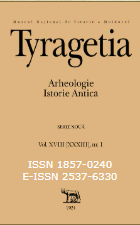Un nou lot de ștampile amforice descoperite la Mangalia (stadionul municipal)
A new lot of amphora stamps discovered in Mangalia (in the area of the Municipal Stadium)
Author(s): Natalia Mateevici, Nicolaie Alexandru, Mihai IonescuSubject(s): Archaeology, Cultural history, Social history, Ancient World
Published by: Muzeul Naţional de Istorie a Moldovei
Keywords: stamps; amphorae; Callatis; manufacturers; magistrates; chronological groups;
Summary/Abstract: Archaeological investigations on the territory of the ancient city of Callatis have provided a wealth of information about the economic, social and political life of this Heraclean colony. The article presents new amphora stamps discovered during excavations in the area of the Mangalia Municipal Stadium. We have distributed the stamps into 33 groups depending on the centers of amphorae production: Sinope, Thasos, Rhodes, Heraclea Pontica, Akanthos, Knidos, Chersonesus and unknown centers. Most of the amphora stamps belong to Sinopian amphorae from the mid-4th century BC - the 60s of the 3rd century BC. We also attributed amphora stamps from other Greek production centers to this chronological period, and one of the two Heraclean stamps is more ancient - the first quarter of the 4th century BC. The absence of amphora stamps from the second half of the 3rd century BC could indicate that during this period the inhabitants of the city changed the burial area, shifting it, according to archaeological data, to the north (2-300 m), where the courtyard of the Municipal Hospital and Nicolae Iorga Street are currently located, on the territory of which burial complexes of the 3rd-2nd centuries BC were discovered.
Journal: Tyragetia (Serie Nouă)
- Issue Year: XVIII/2024
- Issue No: 1
- Page Range: 197-210
- Page Count: 14
- Language: Romanian

